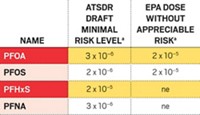Advertisement
Grab your lab coat. Let's get started
Welcome!
Welcome!
Create an account below to get 6 C&EN articles per month, receive newsletters and more - all free.
It seems this is your first time logging in online. Please enter the following information to continue.
As an ACS member you automatically get access to this site. All we need is few more details to create your reading experience.
Not you? Sign in with a different account.
Not you? Sign in with a different account.
ERROR 1
ERROR 1
ERROR 2
ERROR 2
ERROR 2
ERROR 2
ERROR 2
Password and Confirm password must match.
If you have an ACS member number, please enter it here so we can link this account to your membership. (optional)
ERROR 2
ACS values your privacy. By submitting your information, you are gaining access to C&EN and subscribing to our weekly newsletter. We use the information you provide to make your reading experience better, and we will never sell your data to third party members.
Environment
Lead Exposure Limits Are Inadequate
by Jeff Johnson
December 10, 2012
| A version of this story appeared in
Volume 90, Issue 50

Allowable lead levels for U.S. workers, set by the Occupational Safety & Health Administration, are inadequate, according to a National Research Council report released last week. The report, sponsored by the Department of Defense, focused primarily on lead exposure for workers at military firing ranges. It found, however, that OSHA’s current lead exposure limit for all workers is too high. The OSHA standard, set in 1978, is 40 µg of lead per deciliter of blood. This works out to an environmental exposure of 50 µg of lead per m3 of air. Noting that much research has taken place since 1978, NRC says OSHA’s blood lead standard should be one-quarter the current level. The report adds that air recently collected at military ranges exceeds the current standard in some cases by a factor of more than 10.



Join the conversation
Contact the reporter
Submit a Letter to the Editor for publication
Engage with us on Twitter